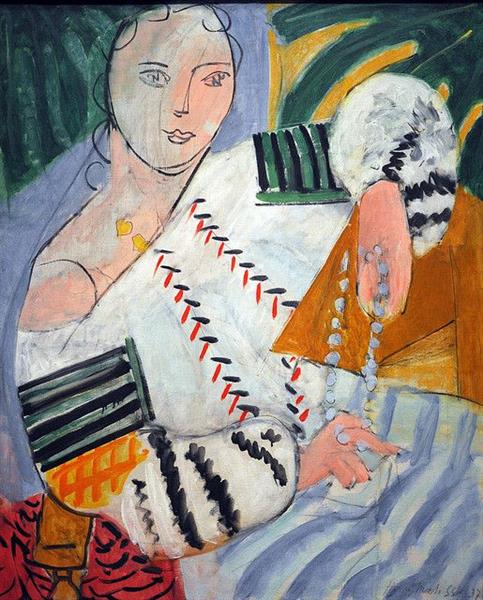Description
In the year 1937, Henri Matisse created a work that, although small in dimensions, radiates an unparalleled presence: "Woman With Necklace." This painting, measuring 49x60 cm, encapsulates the essence of Matisse's mature style, who, after decades of artistic exploration, had come to master a chromatic technique and a compositional sense that continue to amaze viewers and critics alike.
Observing "Woman With Necklace," the first thing that captures our attention is the central and unique figure of a woman. The model stands out for her relaxed posture and serene expression, which intermingle with the surrounding elements in an almost musical way. In this work, Matisse employs his characteristic use of color not to faithfully represent reality, but to express what he himself described as "a harmony that is an analogy of my deepest feeling."
The study of color here is, as always in the work of the French master, revealing. The woman's skin is represented with warm and delicately shaded tones. Her black hair contrasts sharply with the skin and the background, while her clothing shows a simple but effective palette in blues and greens. A key detail is the necklace the figure wears, not only for its decorative presence but also for how Matisse uses its colors to lead the viewer's eye to travel across the entire canvas.
Let's also consider the composition of the work. The figure is centered and occupies most of the space, giving a sense of proximity and connection with the viewer. However, she is surrounded by abstract patterns and geometric shapes that Matisse places with deliberate freedom, creating a dynamism that ultimately frames and highlights the protagonist. This dialogue between the figure and the background is characteristic of his work, where the environment is not merely a context but plays an active role in the composition.
Another interesting aspect lies in the technique Matisse employs. The brushstrokes are visible, and the areas of color seem almost blurred in some zones, contributing a rich and deep texture. This way of applying paint adds to the vibrancy and tactile quality of the work.
The portrayed woman, whose name and exact context are unknown, thus becomes an amalgam of all the muses that inspired Matisse throughout his career. She is not a representation of a specific person but rather an idealized symbol of femininity, calmness, and sublime beauty. This approach differs from traditional portraits that seek to capture a precise identity, and instead, Matisse invites us to contemplate an abstraction of the human experience.
In the context of his broader work, "Woman With Necklace" dialogues particularly well with other works from the same period, where we also find the bold use of color and the simplification of forms. Works like "La Blouse Roumaine" (1940) and "La Musique" (1939) share this reduction of the figure to its purest essences, devoid of unnecessary details but imbued with life and emotion.
In summary, "Woman With Necklace" is a compelling example of Henri Matisse's genius. Through his masterful use of color, form, and composition, Matisse not only presents us with a woman wearing a necklace, but also transports us to a space of contemplation and aesthetic harmony that is distinctively his own. In each stroke, in each combination of tones, his profound understanding and love for visual beauty is perceived, inviting us, the viewers, to immerse ourselves in his vibrant and emotional world.

